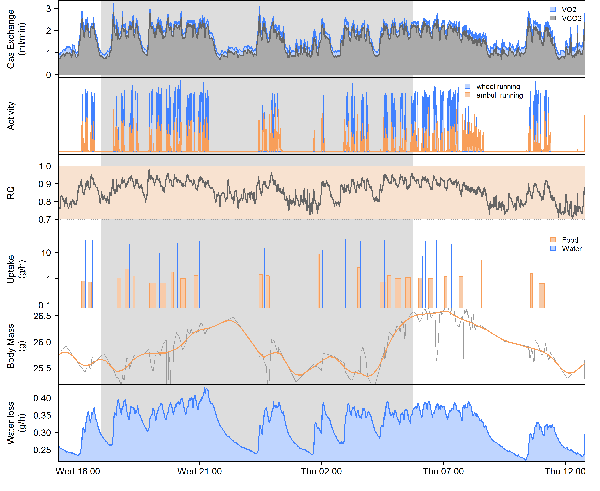Data, data, data!
This shows a day's worth of data from a single mouse in graphic form, recorded by a Promethion-C system for a research study on which I'm collaborating. The time resolution of the data set is one second. Loads of additional data (such as XY position and so on) didn't make it into the graph but are waiting in the wings in case they're called on for duty. Click on the graph* to embiggen it.
So, what's happening? The top panel shows VO2 and VCO2 (rate of O2 consumption and CO2 production, respectively). You can see they're quite variable, and that most of the variability is explained by the next panel, which displays wheel running and non-wheel pedestrian locomotion in blue and orange, respectively. You can see how the VO2 and VCO2 traces faithfully reflect the increased metabolic rate that accompanies locomotion. The next panel, RQ, shows the fuel that the animal is burning. It can vary from 0.7 (fueled entirely by fat) to 1.0 (fueled entirely by carbohydrates). As you can see, when the mouse is running, it shifts the fuel it is burning more towards carbohydrates. Next we have food and water uptake, then below that, the body mass of the mouse. (You might wonder how that's measured; inside the cage there's a cute little habitat attached to a high-resolution mass sensor, and the mouse gets weighed each time it enters and leaves the habitat. The food and water uptake sensors work in a similar, differential way). You can see how the mouse's body weight (or body mass, to be rigorous) increases when it goes through feeding and drinking bouts. And finally, we have something that only Promethion can measure in the metabolic phenotyping arena, which is water loss rate. That's the sum of the water the mouse ate and drank and later excreted, and the water the mouse produced metabolically. You can see how closely it tracks metabolic activity. Metabolic water production can be very significant. Would you believe that 1 gram of fat produces over a gram of metabolic water?
Just a tiny appetizer, a soupçon, of what you can get from a good metabolic phenotyping system.
-- John Lighton
* Thanks to Thomas Förster, Ph.D., Sable Systems International's expert in-house data analysis and data presentation consultant, for creating the graph.
- Log in to post comments
